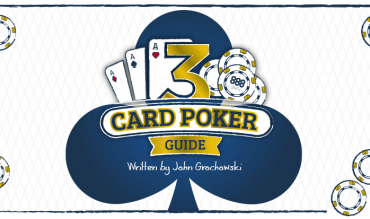THREE CARD POKER OPTIONS
![]()
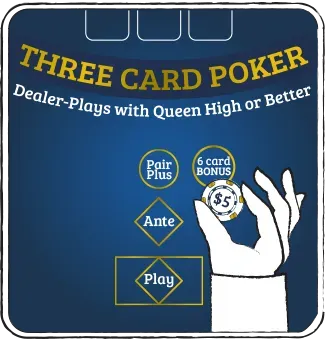
Side bets and main game variations have become an important part of table games in live casinos and online casinos alike. They’re a way to add a little excitement to the basic game with a chance at bigger jackpots.
Three Card Poker has several side bets available. They are not mandatory; you may play the main game with or without making the side bets. There also are game variations in which betting patterns and payoffs are different than in basic three Card Poker.
In this chapter, you’ll learn about the following Three Card Poker side bets:
- The Six-Card Bonus Bet
- Progressive Three Card Poker
- Three Card Poker Prime
You’ll also learn about the following game variation:
- Ultimate Three Card Poker
THE SIX-CARD BONUS BET
Players who want a shot at bigger jackpots than you can find on standard Pair Plus can find an opportunity on the Six-Card Bonus bet.
Like Pair Plus, it pays according to a pay table, and you do not have to beat the dealer. That’s made possible by combining the player’s three cards with the dealer’s three cards and comparing the best five-card poker hand to the pay table.
The big payoff, usually 1,000-1 but sometimes 2,000-1, is on a royal flush – Ace-King-Queen-Jack-10 of the same suit. The lowest payoff, usually 5-1 but sometimes 7-1, is on three of a kind. Instead of the 22,100 possible three-card combinations, there are 20,358,520 possible five-card poker hands when six cards are dealt.
A five-card royal occurs in six cards an average of once per 1,131,028 hands. Compare that to the once per 5,525 hands for a mini-royal in three cards and you’ll see why casinos can pay bigger jackpots on the Six-Card Bonus than on Pair Plus.
Here’s the breakdown:
| Hand | Number of combinations |
| Royal flush | 188 |
| Straight flush | 1,656 |
| Four of a kind | 14,664 |
| Full house | 165,984 |
| Flush | 205,792 |
| Straight | 361,620 |
| Three of a kind | 732,160 |
| Non-winners | 18,876,456 |
Note that in this bonus bet, straights occur more frequently than flushes, the opposite of the situation with three-card hands. Therefore, flushes bring bigger payoffs than straights. The house edge depends on the pay table.
Here are a few available pay tables and their house edges
| Hand | Payoffs A | Payoffs B | Payoffs C |
| Royal flush | 1,000-1 | 2,000-1 | 1,000-1 |
| Straight flush | 200-1 | 200-1 | 200-1 |
| Four of a kind | 100-1 | 50-1 | 50-1 |
| Full house | 20-1 | 25-1 | 25-1 |
| Flush | 15-1 | 15-1 | 15-1 |
| Straight | 10-1 | 10-1 | 10-1 |
| Three of a kind | 7-1 | 5-1 | 5-1 |
| House edge | 8.6% | 14.4% | 15.3% |
The lowest house edge comes with the highest payoffs on three of a kind. It occurs more often than other hands, so players collect that higher payoff frequently.
![]()
KEY TAKEAWAYS
- The Six-Card Bonus bet pays off on the best five-card hand that can be made from the player’s three cards and the dealer’s three cards.
- The biggest payoff is on a five-card royal flush. It usually pays 1,000-1, but some pay tables top out at 2,000-1.
- The house edge is lowest when the most frequent winner – three of a kind – pays 7-1 instead of 5-1.
![]()
PROGRESSIVE THREE CARD POKER
The main game is the same as on regular Three Card Poker tables. You can play Pair Plus, ante-play or both.
Players also have the option of making a $1 side bet on progressive jackpot.
A portion of each wager is added to the jackpot.
Payoffs are made according to a pay table that has a flush as the lowest-ranking winning hand, with other payouts on straight flushes and mini-royals.
In addition, there is an envy bonus. Whenever one player wins big with a mini-royal, other players collect a smaller reward.

Here is the pay table:
| Hand | Payoff | Envy bonus |
| ?A ?K ?Q Mini-royal in spades | Full progressive jackpot | $100 |
| ?A ?K ?Q Mini-royal in hearts, $500 diamonds or clubs | $500 | $25 |
| ?7 ?8 ?9 Straight flush | $100 | 0 |
| ?2 ?2 ?2 Three of a kind | $90 | 0 |
The house edge is dependent on the size of the royal flush. With a $1,000 jackpot, it’s 43.3 percent. At $5,000 it’s 25.3 percent, and at $10,000 it’s 2.7 percent.
In addition, the envy bonus means having more players at the table lowers the house edge. For each player at the table, the house edge drops by about 0.8 percent.
That makes for a very social game, where players are rooting for each other to get the big hands.
![]()
KEY TAKEAWAYS
- Playing for the progressive jackpot requires a $1 side bet, but you don’t make to make the bet in order to play the main Three Card Poker game.
- A portion of each bet is added to the jackpot.
- A mini-royal in spades wins the full jackpot, with smaller payouts for other mini-royals, straight flushes and three of a kind.
![]()
THREE CARD POKER PRIME
In the Prime side bet, you’re wagering that all three cards in your hand, or all six cards in your hand plus the dealer’s hand, will be the same color.
As with other side bets, this is optional. You can play Pair Plus or ante-play without making the Prime bet.
Winning hands do not have to be all in the same suit. Any mix of hearts and diamonds are all red, and any mix of spades and clubs are all black.
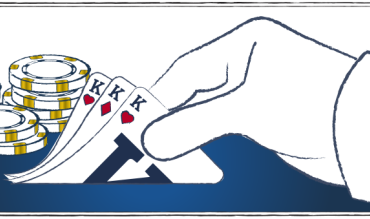
Payoffs are according to this pay table:
| Hand | Payoff |
| ?7 ?3 ? 9 ?J ?A ?K 6 cards of the same color | 4-1 |
| ?5 ?3 ?8 3 player cards of the same color | 3-1 |
You will have a winner on Prime about 23.5 percent of the time, and the house edge is about 3.6 percent.
![]()
KEY TAKEAWAYS
- The Prime bet pays off if all cards are the same color, even if the suits are mixed.
- Prime winners can be based either on the player’s three cards or the combination of the player’s and dealer’s cards.
![]()
ULTIMATE THREE CARD POKER
Instead of a side bet, Ultimate Three Card Poker is a game variation in which the play bet can be three times the ante instead of equal to the ante.
There are both ante-play and Pair Plus options. Pair Plus is the same as in standard Three Card Poker.
There are several differences in ante-play.
- There is no ante bonus.
- Instead of starting with just an ante, the player must begin with an ante and a blind bet equal to the ante.
- After the player sees his cards, he may make a bet equal to his ante if he does not have a pair or better.
- However, if the player has a pair or better, the play bet can be one, two or three times the ante.
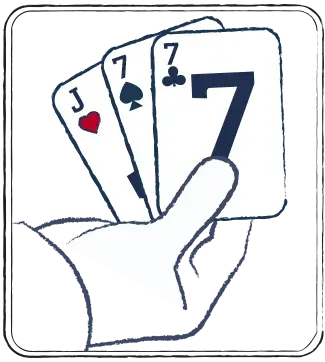
After all decisions are made, the ante and play bets are decided as in standard Three Card Poker.
If the dealer does not have a Queen or better, he does not play. Antes are paid at even money and play bets push.
If the dealer has a Queen or better, players must beat the dealer to win, and winners are paid even money on both ante and play bet.
To win the blind bet, you must beat the dealer. If you fold or if the dealer has the better hand, you lose the blind bet.
If the player wins the poker hand, the blind bet is paid according to this pay table:
| Hand | Payoff |
| Mini-royal | 100-1 |
| Straight flush | 20-1 |
| Three of a kind | 10-1 |
| Straight | 2-1 |
| Flush | 1-1 |
| Pair or less | Push |
Strategy differs slightly from the standard Three Card Poker strategy.
That’s because of the effect of the blind bet. You bet more hands than in standard Three Card Poker largely in order to keep from forfeiting the blind bet.
Make the maximum play bet of three times the ante with any pair or better. Bet an equal amount to the ante with Jack-7-4 or better, and fold with lesser hands.
It is never to your advantage to bet just twice the ante. Either make your bet equal the ante, or, if you have pair or better, make the maximum bet of three times the ante.
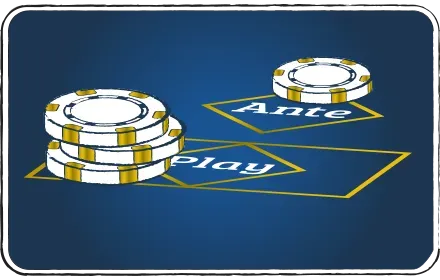
That leads to a house edge of 5.4 percent of your ante or 1.7 percent of total action.
![]()
KEY TAKEAWAYS
- In Ultimate Three Card Poker, you may make a play bet of up to three times your ante.
- Ultimate Three Card Poker adds a mandatory blind bet to ante-play, but does not have an ante bonus.
- Pair Plus is the same in Ultimate Three Card Poker as in the standard game.
![]()
QUIZ
- What cards are used to make up a hand on the Six-Card Bonus bet?
- Why can the Six-Card Bonus bet pay bigger jackpots than Pair Plus?
- How much does a player who is dealt a mini-royal in spades win in Progressive Three Card Poker?
- What hands are winners in Three Card Poker Prime?
- In Ultimate Three Card Poker, should you ever make a play bet of twice your ante?
QUIZ ANSWERS
- To make up a hand on the Six-Card Bonus bet, the player’s three cards and the dealer’s three cards are used. The final hand is the best five-card hand that can be made from those six cards.
- The Six-Card Bonus bet can pay bigger jackpots than Pair Plus because the odds against drawing the top paying hand are much larger. You’ll see a five-card royal among six cards an average of once per 1,131,028 hands, while you see a three-card mini-royal an average of once per 5,525 hands.
- A player who is dealt a mini-royal in spades in Progressive Three Card Poker wins the full progressive jackpot. That varies because a portion of each bet is added to the jackpot.
- In Three Card Poker Prime, you win if your three cards are the same color, or if you three cards and the dealer’s three cards all are the same color.
- No, in Ultimate Three Card Poker, should you never make a play bet of twice your ante. Make the maximum of three times the ante if you have a pair or better, or make a play bet equal to the ante if you a lesser hand of Jack-7-4 or better.
Written by John Grochowski
![]()
